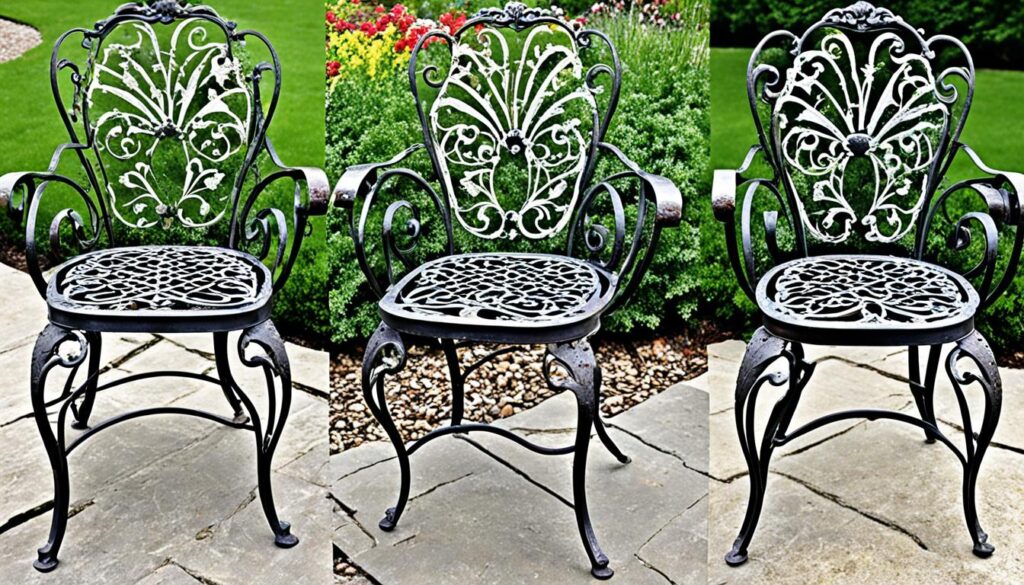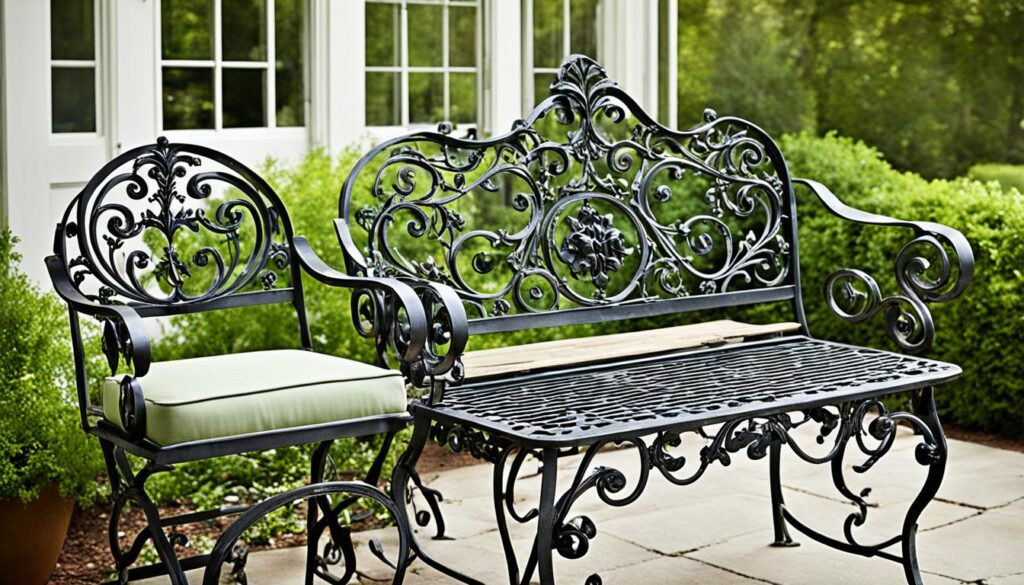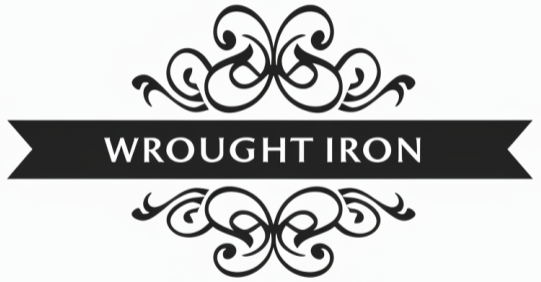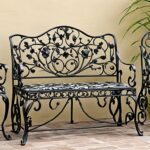
Have you ever found an old piece of antique iron furniture and felt a deep connection? It’s like it tells stories from another time. Vintage wrought iron furniture combines intricate designs with strong build. This mix makes it timeless and continues to attract people from all ages.
Restoring vintage wrought iron furniture means you’re part of history. You’ll see details like scrollwork, flowers, or shapes that show the skill of old times1. These beds often have curves and swirls, giving them a romantic look that’s hard to find today1. Such details show it’s the real deal.
Knowing the history of these items helps spot the real deal from copies. These strong pieces with detailed carvings share stories of the past2. The Victorian era made them popular, so look for signs of quality and design1. Spotting Victorian or Art Nouveau styles, like big headboards or vines, is key.
Key Takeaways
- Vintage wrought iron furniture often features detailed scrollwork, floral motifs, and geometric patterns1.
- Look for curved lines and swirls to identify genuine vintage pieces1.
- Quality craftsmanship is crucial for determining the authenticity of antique iron furniture1.
- Victorian-era pieces usually have large, intricate headboards and footboards1.
- Art Nouveau items often display nature-inspired designs like flowing vines1.
Understanding the History of Wrought Iron Furniture
The history of wrought iron furniture is a captivating story. It shows how craftsmanship and materials have changed over time. Knowing this history helps us spot antique wrought iron and value its lasting beauty.
The Origins and Popularity
Wrought iron furniture began in Asia Minor around the 2nd millennium BC. It replaced cast bronze for many uses3. Its flexibility and strength made it perfect for making detailed and strong items4.
In the Anatolian peninsula by 2000 BC, wrought iron was a big hit. It stayed popular in building until the 19th century3. Its ability to resist rust and easy upkeep made it a favorite choice4.
Key Historical Periods
In the Middle Ages, wrought iron spread even more, especially in Europe. By the 3rd century BC, it had taken over many uses, replacing cast bronze3. The Victorian era brought a surge in wrought iron furniture for gardens and decoration. Designs got more complex and fancy.
Karl Friedrich Schinkel introduced cast iron garden furniture in the early 1800s. It quickly became very popular3. Making wrought iron garden furniture was hard work. So, many pieces left today are seen as antiques or handmade gems3. They often have marks and unique designs that show where they came from and if they’re real5.
From 1842 to 1883, British metal products got a special mark. This mark showed where they were made, helping us spot antique wrought iron5.
Specific Characteristics of Vintage Wrought Iron Furniture
Vintage wrought iron furniture stands out because of its unique features and top-notch craftsmanship. When looking for vintage pieces, pay attention to hand-forged details and decorative elements. These are key.
Hand-Forged Details
Hand-forged vintage wrought iron is known for its visible hammer marks and welds. These signs show the hard work of the craftsmen. Unlike mass-produced items, these marks are unique.
This type of iron is over 99% pure, making it strong and free from impurities that could weaken it6. It has a grain like wood because of its low carbon content6. For centuries, it has been used in outdoor furniture, proving its durability6.
Intricate Designs and Decorative Elements
Intricate designs are a big part of what makes vintage wrought iron furniture special. You’ll see scrollwork, floral patterns, and geometric shapes. These designs reflect the styles of different times, like Victorian and Art Deco1.
The skill in making these pieces is clear in their elegant curves and detailed designs. Wrought iron can be shaped into many forms when heated and hammered6. The designs not only look great but also show the high skill of the craftsmen.
Examining Quality and Construction Materials
Looking at the weight and density of iron furniture is a good way to check its quality. Vintage wrought iron decor is often heavier and denser, making it more durable. For instance, Salterini, a top brand in vintage patio furniture, uses strong powder-coated wrought iron that lasts for decades7. Real vintage items are usually much heavier than newer copies.
Checking the frame thickness is also important. Old iron furniture often has thicker frames, showing it’s built to last. Also, looking at the joints is key. Antique furniture makers used advanced joints like dovetail joints in the late 17th and 18th centuries8. These joints show the high level of craftsmanship.

Spotting the patina or distressed finishes on vintage wrought iron decor is vital. These finishes develop over time and add to the piece’s unique look and authenticity. For example, Salterini’s designs have intricate patterns and details that show their quality and craftsmanship7.
In short, checking the weight, frame thickness, joint types, and finishes helps spot genuine high-quality iron furniture. These factors clearly show if a piece is truly vintage and made with great skill.
Identifying Manufacturer Markings and Labels
Finding wrought iron furniture markings and labels is key to knowing your piece’s history and value. These signs can show important info about the maker and when it was made. Companies like Woodard, famous for making outdoor furniture for over 150 years, often put their logo on the furniture. You can find these marks under the seat, on the armrests, or on the backrest9.
Knowing how to care for antique wrought iron furniture is also crucial. For example, vintage Woodard furniture might have rust spots or a patina. These are signs of age and realness, not flaws9. It’s important to keep moisture levels down and use protective coatings to keep these historical items safe9. Storing your vintage pieces in a dry place when not in use can also help prevent rust and keep them lasting longer9.
Serial numbers can also be a big help. They can pinpoint when the piece was made and prove it’s genuine. Before 1860, many vintage items were made by hand, not by machines10. If your furniture has handmade dovetails on the drawers, it was likely made before the machine-cut era10.
Mid-century modern design started in the 1930s and lasted until the 1960s. It brought us iconic pieces from designers like Charles and Ray Eames11. Looking for specific design features and marks can tell you if you have a true piece from this era. Knowing these details not only boosts the value but also the appreciation of your antique wrought iron furniture care and effort.
How to Identify Vintage Wrought Iron Mapurniture
Identifying vintage wrought iron furniture involves looking at several key features. These pieces are often heavier and have thicker frames than modern ones. This is because they use denser, higher-quality iron12. Look for hand-forged details like hammer marks and welds to tell them apart from machine-made items12.
Also, vintage wrought iron furniture often has intricate designs and decorations. You might see leaves, flowers, and vines, which were popular in the 19th century12. Markings and labels from the makers, including the year produced, help prove if it’s genuine12.

Mid-century Woodard patio furniture, made from the 1950s to the 1970s, is sought after for its detailed designs9. Founded in 1866, Woodard is famous for its durable and intricate furniture. These pieces may show signs of aging like rust spots or slight pitting9. These signs can also help you negotiate a better price during an appraisal.
Checking the furniture’s weight is another way to spot vintage pieces. They usually weigh more than modern ones9. Getting advice from antique dealers, appraisers, or collectors is key to understanding a piece’s history and value12. Even without marks, vintage chairs can be worth over $10013.
Lastly, look for unique signs like mold lines, hammered textures, and rust to tell vintage wrought iron apart from cast iron. These features help in a precise wrought iron furniture appraisal13.
Exploring Different Styles of Vintage Wrought Iron Decor
Vintage wrought iron decor has a timeless charm. It shows off different styles and details from various eras. Knowing these styles helps you spot and value real vintage items.
Victorian Era Designs
Victorian wrought iron is famous for its detailed and fancy designs. You’ll see lots of scrollwork, flowers, and shapes. This shows the skill of the time1. Antique iron beds come in styles like Victorian, Art Deco, and Art Nouveau14. Their mix of fancy details and a worn look makes them special and valuable1.

Modern Imitations vs. Genuine Pieces
Telling real vintage wrought iron from fake ones can be hard but important. Real vintage pieces get a unique look over time1. They look rougher than cast iron because of their texture1. Wrought iron furniture is strong and made by hand. It often has a special coating that stops rust4. Fake ones might not have the same level of detail or history as the real thing4. Keeping up with care, like not using harsh cleaners, keeps vintage wrought iron looking great14.
Consulting Experts for Authenticity and Appraisal
When checking if vintage wrought iron furniture is real, getting help from experts is key. A pro can tell you where it came from and what it’s worth. Vicky Nash Shaw, an ISA certified appraiser, knows a lot about American, French, English, and Chinese furniture15. She’s a great person to talk to if you’re thinking about fixing up vintage wrought iron furniture.
Experts are not just for checking if something’s real; they’re also key for insurance and investment. The Appraisers Association of America in New York says appraisal costs can be $200 to $40016. This price makes sure your piece is valued right, protecting it from loss.
When picking an expert, look at their area of focus and their qualifications. Vicky Nash Shaw knows a lot about American and Asian ceramics, and she’s studied traditional crafts15. Good appraisers understand history, materials, and where things came from. They use different methods, like looking closely or using special tools, to check things out17.
It’s easier to find the right expert through groups like the Appraisers Association of America16. They have over 500 members who know about fine and decorative arts. The International Society of Appraisers, with about 900 members in North America, focuses on appraising personal property16. Being in these groups shows they’re serious about their work.
Here’s a look at the top appraisal groups to help you pick the right one:
| Organization | Number of Members | Specializations |
|---|---|---|
| Appraisers Association of America | 500+ | Fine and Decorative Arts, Jewelry, Household Contents |
| American Society of Appraisers | 5,000+ | African Sculpture, Violins, Personal Property |
| International Society of Appraisers | 900+ | Personal Property Appraisals |
In the end, getting a good expert for your wrought iron furniture is key. They help prove it’s real and guide you on fixing it up. With their help, you keep your valuable pieces safe and sound.
Conclusion
Finding real vintage wrought iron furniture means knowing a lot about history and design. The detailed work and special looks of old iron pieces show the skill of blacksmiths. They also show the lasting beauty of these items18. Spotting real signs like early 17th century ball- and claw-style feet helps tell real antiques from fake ones19.
Knowing how furniture was made and what materials were used is key to spotting vintage pieces. Signs like dovetail joints and small marks from hand tools mean a piece is likely old and real20. Looking at these signs helps you know the furniture’s history and value19. Also, the rustic look and detailed designs of wrought iron furniture make any room look better and more meaningful18.
Getting advice from experts helps make sure you know your vintage wrought iron furniture is real and valuable. This guide shows why it’s important to check things closely and know how to care for and restore antique wrought iron furniture. By doing this, you can keep your antique items looking great for many years19.
FAQ
How can I identify vintage wrought iron furniture?
What is the history of wrought iron furniture?
What are the unique characteristics of vintage wrought iron furniture?
How can I differentiate between high-quality iron and modern materials?
Where can I find manufacturer markings and labels on wrought iron furniture?
What are the key historical periods that influenced wrought iron furniture designs?
How do I distinguish between modern imitations and genuine vintage wrought iron furniture?
Why should I consult experts for wrought iron furniture appraisal?
What steps are involved in vintage wrought iron furniture restoration?
Source Links
- A Guide to Identifying Antique Iron Bed Styles | Cathouse – https://www.cathousebeds.com/decoding-timeless-elegance-a-guide-to-identifying-antique-iron-bed-styles/
- Your Guide to Identifying Vintage Furniture – Carrocel – https://www.carrocel.com/how-to-identify-vintage-furniture/
- The history of metal garden furniture – https://www.lazysusanfurniture.co.uk/blog/garden-furniture/the-history-of-metal-garden-furniture/
- Everything About Wrought Iron Furniture [With Images] – https://www.sierralivingconcepts.com/blog/everything-about-wrought-iron-furniture/
- British and American Cast-Iron Garden Seats by Barbara Israel from Antiques & Fine Art magazine – http://www.antiquesandfineart.com/articles/article.cfm?request=224
- Patio Productions – https://www.patioproductions.com/wrought-iron-furniture-buyers-guide.html
- How to Identify Salterini Patio Furniture – Patio Fix | Your Patio Fixes Guide – https://www.thepatiofixes.com/how-to-identify-salterini-patio-furniture/
- Antique Furniture Construction – Antiques World – https://antiquesworld.co.uk/antique-furniture-construction/
- How to Identify Vintage Woodard Patio Furniture – Patio Fix | Your Patio Fixes Guide – https://www.thepatiofixes.com/how-to-identify-vintage-woodard-patio-furniture/
- Identifying Antique Furniture and Furnishings – – https://antique-marks.com/identifying-antique-furniture.html
- A Guide to Identifying Vintage Furniture Styles | The Spalty Dog – https://www.thespaltydog.com/blog/a-guide-to-identifying-vintage-furniture-styles
- How to identify vintage wrought iron furniture – https://www.acottageinthecity.com/blogs/news/how-to-identify-vintage-wrought-iron-furniture
- Add a classic, rustic flair to your outdoor space with these tips to find authentic wrought iron pieces – https://www.happysprout.com/outdoor-living/identify-vintage-garden-furniture/
- The Caretaker’s Guide to Antique Iron Beds – https://www.cathousebeds.com/preserving-history-the-caretakers-guide-to-antique-iron-beds/
- Authentic Appraisals – Vicky Nash Shaw – http://www.theauthenticappraisal.com/specialty_training.php
- Antique Appraisals, How to Find an Appraiser – Consumer Reports – https://www.consumerreports.org/cro/magazine/2012/10/how-much-is-your-stuff-worth/index.htm
- Appraising Artifacts and Antiquities: Evaluating Historical Finds – https://www.appraiseitnow.com/blog/appraising-artifacts-and-antiquities-evaluating-historical-finds
- A Comprehensive Guide to Antique Iron Beds – https://www.cathousebeds.com/unveiling-the-timeless-charm-a-comprehensive-guide-to-antique-iron-beds/
- Identifying Antique Furniture Styles « – https://antique-marks.com/identifying-antique-furniture-styles.html
- How to Identify, Date & Value Antique Chairs: A Beginner’s Guide – Paolo Moschino – https://www.paolomoschino.com/how-to-identify-date-value-antique-chairs-a-beginners-guide/




